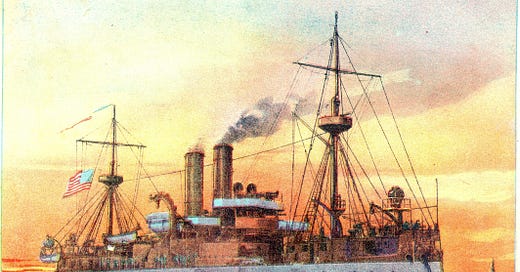TDIH: USS Maine explodes
To this day, no one knows exactly why the warship was destroyed. But at the time, Americans were pretty sure that Spain was to blame.
On this day in 1898, USS Maine explodes in Havana Harbor. To this day, no one knows exactly why the warship was destroyed. But at the time, Americans were pretty sure that Spain was to blame.
You can imagine that didn’t go too well.
Spain was then in a period of transition. It had long been a powerful influence in the New World, but now it was losing its foothold in the western hemisphere. Its main remaining possessions were Cuba and Puerto Rico. On the other side of the Pacific, it retained islands in and around the Philippines.
By the 1890s, even those interests were in trouble. Cubans were fighting for their independence. Puerto Ricans were split between those who wanted autonomy and those who wanted to join the United States. Filipinos, too, were chafing under Spanish rule.
Meanwhile, American trade interests were being affected, and many Americans sympathized with the plight of Cubans. It hadn’t been *that* long since the American Revolution, and many felt they saw similarities between the two fights for independence. Tensions between Spain and the United States began to increase.
It didn’t take much to light a blaze in that tense atmosphere. On February 15, 1898, USS Maine exploded while docked in Havana Harbor. Many Americans immediately suspected Spanish involvement, and a Naval Court of Inquiry seemed to confirm these suspicions when it reported that the Maine was destroyed by a submerged mine.
President William McKinley soon sent a message to Congress. “The present condition of affairs in Cuba,” he wrote, “is a constant menace to our peace . . . .” He asked for authorization to “secure a full and final termination of hostilities between the Government of Spain and the people of Cuba . . . and to use the military and naval forces of the United States as may be necessary for these purposes.”
Congress complied, approving a resolution that recognized Cuban independence and demanded that Spain do the same. It also clarified that the United States had no intention of annexing Cuba. Spain responded by severing diplomatic relations.
Future Secretary of State John Hay would describe the war that followed as a “splendid little war.” Americans won an early naval battle at Manila Bay. In July, the Battle of San Juan Hill was fought—with the well-known assistance of Teddy Roosevelt and his Rough Riders. Unconditional surrender was soon made in Cuba and Puerto Rico. For its part, Guam had surrendered with little fanfare. On August 12, a ceasefire was signed. Ultimately, Cuban independence would be recognized. Puerto Rico and Guam were ceded to the United States, and the Philippines was sold to the United States for $20 million. In a separate but simultaneous move, the United States annexed Hawaii.
And what of USS Maine? In the years that followed, many would attempt to nail down the real cause of the explosion. There will always be some mystery surrounding the event, but it seems likely that Spain was not responsible after all. Instead, the tragedy may have been caused by an internal coal fire which ignited magazines aboard the ship.
What an odd twist. A war prompted by a misbelief. But it was also a war that established the United States as a Pacific power within a matter of months.
Sources can always be found on my website, here.





It is easy to point to one trigger event as a cause or pretext for a conflict but the growing political unrest and global instability that leads to the event is what inflames the passions and forms the rationale for it and it's potential opportunities.
I don't think that I have read this compilation of events quite this way but I like that the United States took such definitive action for Cuban Independence. A package deal with Guam, the Philippines and Hawaii as a bonus. Not a bad deal for the United States of America.
Thank you Tara.